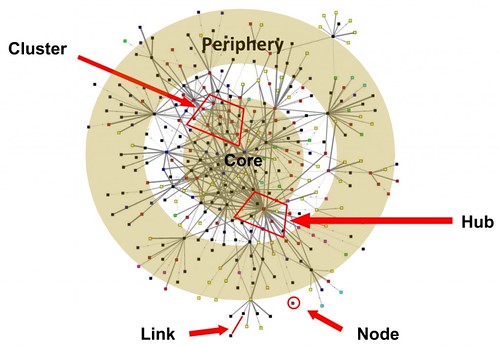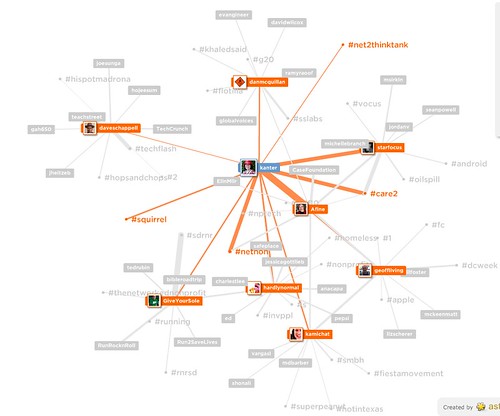
Source: Monitor Institute
Yesterday, Allison Fine and I, along with colleagues Danielle Bridiga and Marc Sirkin gave a Care 2 Webinar on the Networked Nonprofit. Here’s a link to a summary and the recording over at the Care 2 Frogloop blog.
One of the topics was “How to understand social networks through social network analysis and mapping techniques.” I thought I’d expand on it here.
As someone who loves to play with analytics, visuals, maps, and other geekery, I explored some of the tools and techniques to apply some of the big ideas about understanding social networks that are our book, The Networked Nonprofit. My notes follow below, but let’s begin with some of the big picture ideas about what it is and why you’d even use it.
The above visual is a social network. Each dot represents a person or in network jargon, a node. A connection between people is called link. The definition of links or how you’re connected is defined however you want in social network analysis. Some examples:
- A follower on Twitter or someone you’re following
- Someone on your mailing list or rolodex
- Someone you know well enough to call
- Family members
- Organizational reporting
- Communications flows
- Information flows
As you can see there are many different ways to apply social networking analysis to understanding networks. It is really a technique to understand relationships. One of the first social networking analysis map was created by Jacob Moreno. It looked at the relationships between players on a football team. Who liked each other, who didn’t. Apparently this team chemistry is important to winning.
In the book, we talk about the using low tech tools like crayons or post-it notes to map out your network. Marty Kearns has a diagnostic tool over in his Advocacy 2.0 wiki that gives you a good set of questions to ask after you’ve created a descriptive drawing. Net-Map Tool Kit is an interview-based low-tech mapping tool that helps people understand, visualize, discuss, and improve situations in which many different actors influence outcomes in a community or network. It includes a step-by-step guided approach.
What I’m most interested is how to use social network analysis and the various tools to better understand your network on Twitter or Facebook or elsewhere. You need software to do it. Without social networking analysis, it’s like a weatherman trying to predict a snowstorm without seeing a whole weather map. Social network analysis gives you a 10,000 view of your ecosystem. Without this visualization, it’s like three blind men touching the elephant. There’s too much unstructured data (comments, replies, likes, etc) – you need to see a picture or map.
When you map your network, it tells you a story. Who is connected to whom? How are they interacting? Where are the clusters? Who are the influencers? Who are the bridge builders between clusters? Who is in the edges? Who isn’t connected? Who should I spend my time responding to and cultivating? The analysis looks at frequency of interaction, relationship structure (two-way, one-way), and helps reveal structural similarities.
Using this information to shape and refine your social media strategy can make it more effective.
There are some free tools that can help you visualize your Twitter network or do quasi social network analysis on Twitter. Here’s a few that I’ve used.
Use Friend or Follow to download a spreadsheet of followers. Sort the information to find influencers and people to get to know. This works best if you have small network.
Mr. Tweet finds influencers in your network you should follow (use this after you have built up your following list).
Mailana can help you identify people who are influencers. I wrote about an experiment I did last year using this tool. One problem is that it doesn’t analyze your network in real time. You submit the userid and then have to come back a few days later unless it is already in the database.
Twitalyzer is a terrific analytics tool that gives you some good benchmarking metrics for Twitter. Run the impact report to help you identify influencers.
Twiangulate lets you analyze cross over between your Twitter network and another Twitter user. This can be useful to find potential collaborators.

Mention Map helps you visualize who is interacting with you around which hashtags. It shows nodes on your network. There is not information about what exactly how the drawings are created though.
NodeXL Created by a Marc Smith, a self-described “Internet Sociologist,” this FREE software works as an add-on template in Excel, allows you import data from Twitter, Flickr, YouTube, and Email and create social network analysis maps. It doesn’t require that you know a programming language, although you need to understand the basic vocabularly of social network analysis and how to translate this to your social media strategy.
There’s are more Twitter tools to explore here.
I also learned about a tool from Care 2 called “Social Network Tracker.” It matches your list of supporters against all of the major social networks. It will tell you which of your donors/activists are on social networks, what social networks they are on and how many friends they have in aggregate.
How are you using social network analysis techniques and tools to analyze your network? How has this helped your strategy become more effective?
